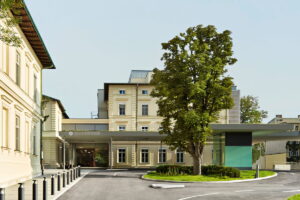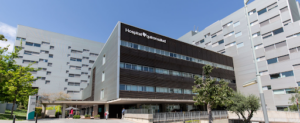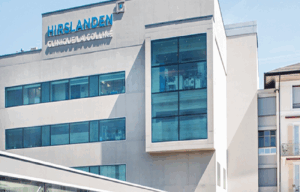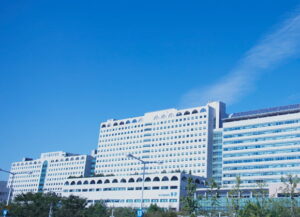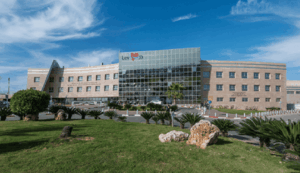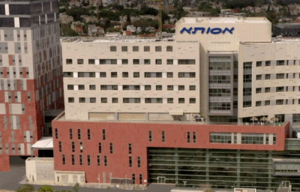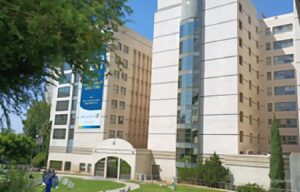Pituitary adenoma
Disease description
A pituitary adenoma is a benign tumor that develops from pituitary cells (a gland located at the base of the brain that regulates the endocrine system). Pituitary adenomas can be hormonally active or inactive. Hormonally active adenomas may cause excessive hormone production, leading to various endocrine disorders such as acromegaly, Cushing’s disease, hyperprolactinemia, and others. Hormonally inactive adenomas typically manifest through pressure on adjacent tissues and related complications.
Symptoms requiring diagnosis and treatment:
- Headaches unresponsive to conventional treatment
- Visual disturbances (most commonly peripheral vision loss)
- Hormonal imbalances: weight changes, menstrual irregularities, decreased libido
- Persistent fatigue and weakness
- Mood changes and depression
- Excessive hair growth or acromegaly
Diagnostic and treatment methods
Diagnosis
Diagnosis of pituitary adenoma involves contrast-enhanced MRI to visualize the tumor and assess its size. Computed tomography (CT) is used when MRI cannot be performed. Blood and urine tests are ordered to evaluate hormone levels, including prolactin, cortisol, growth hormone, and adrenocorticotropic hormone (ACTH). Ophthalmological examination is performed to detect visual field defects caused by tumor pressure on the optic nerve.
Treatment
Treatment of pituitary adenoma depends on the tumor’s size, type, and its effects on hormonal balance and vision. Small, inactive tumors causing no symptoms may be monitored. For hormonally active tumors, medication is often prescribed to normalize hormone levels. Surgical removal via the nasal passage (transsphenoidal surgery) is the preferred method for large or active adenomas. Radiation therapy may be used when surgical removal is not possible or insufficiently effective.
Innovations in global clinics
Methods of personalized medicine are actively developing, including molecular diagnostics that enable selection of targeted and immunotherapeutic drugs based on the tumor’s genetic characteristics.
In recent years, new techniques have emerged, such as focused ultrasound for non-invasive tumor ablation and nanoparticle applications for direct drug delivery to tumor cells.
Procedures
Top clinics
-
 Duisburg-Nord Hospital of the Niederrein Complex
Duisburg-Nord Hospital of the Niederrein Complex -
 University Hospital Freiburg
University Hospital Freiburg -
 Acibadem Altunizade Clinic
Acibadem Altunizade Clinic -
 Ajibadem Atasehir Clinic
Ajibadem Atasehir Clinic -
 Dubai, UAE NMC Healthcare
Dubai, UAE NMC Healthcare -
 Shishli Memorial Clinic.
Shishli Memorial Clinic. -
 Milan, Italy San Raffaele University Hospital
Milan, Italy San Raffaele University Hospital -
 American Hospital Dubai
American Hospital Dubai -
 Burjeel Hospital Abu Dhabi
Burjeel Hospital Abu Dhabi -
 Debling Private Clinic
Debling Private Clinic -
 Rudolfinerhaus Private Clinic.
Rudolfinerhaus Private Clinic. -
 University Hospital Heidelberg
University Hospital Heidelberg -
 Vienna, Austria Wiener Privatklinik (WPK)
Vienna, Austria Wiener Privatklinik (WPK) -
 Gil Medical Center at Gachon University
Gil Medical Center at Gachon University -
 Clinique Genolier
Clinique Genolier -
 Ataşehir Memorial Clinic
Ataşehir Memorial Clinic -
 Memorial Antalya Hastanesi
Memorial Antalya Hastanesi -
 Barcelona, Spain QuironSalud Barcelona Hospital
Barcelona, Spain QuironSalud Barcelona Hospital -
 Barcelona, Spain Medical Center "Teknon"
Barcelona, Spain Medical Center "Teknon" -
 Barcelona, Spain Sant Joan de Deu Children's Hospital
Barcelona, Spain Sant Joan de Deu Children's Hospital -
 Barcelona, Spain University Hospital Barnaclinic+
Barcelona, Spain University Hospital Barnaclinic+ -
 Gebze, Turkey Anadolu Clinic
Gebze, Turkey Anadolu Clinic -
 Zurich, Switzerland Hirslanden Clinic
Zurich, Switzerland Hirslanden Clinic -
 Petah Tikva, Israel Schneider Children's Medical Center
Petah Tikva, Israel Schneider Children's Medical Center -
 Seoul, South Korea Samsung Medical Center
Seoul, South Korea Samsung Medical Center -
 Seoul, South Korea Medical Center at Ewha Womans University
Seoul, South Korea Medical Center at Ewha Womans University -
 SNUH
SNUH -
 г. Женева, Швейцария Клиника «Женераль-Болье»
г. Женева, Швейцария Клиника «Женераль-Болье» -
 г. Женева, Швейцария Hirslanden Clinique La Colline
г. Женева, Швейцария Hirslanden Clinique La Colline -
 г. Стамбул, Турция Университетская клиника «Медиполь Мега»
г. Стамбул, Турция Университетская клиника «Медиполь Мега» -
 г. Стамбул, Турция Клиника Флоренс Найтингейл
г. Стамбул, Турция Клиника Флоренс Найтингейл -
 г. Сеул, Южная Корея Медицинский центр «Асан»
г. Сеул, Южная Корея Медицинский центр «Асан» -
 г. Рамат-Ган, Израиль Клиника Шиба
г. Рамат-Ган, Израиль Клиника Шиба -
 г. Тель Авив, Израиль Медицинский центр “Ассута”
г. Тель Авив, Израиль Медицинский центр “Ассута” -
 г. Петах-Тиква, Израиль Медицинский центр имени Ицхака Рабина
г. Петах-Тиква, Израиль Медицинский центр имени Ицхака Рабина -
 г. Иерусалим, Израиль Медицинский центр “Хадасса”
г. Иерусалим, Израиль Медицинский центр “Хадасса”









